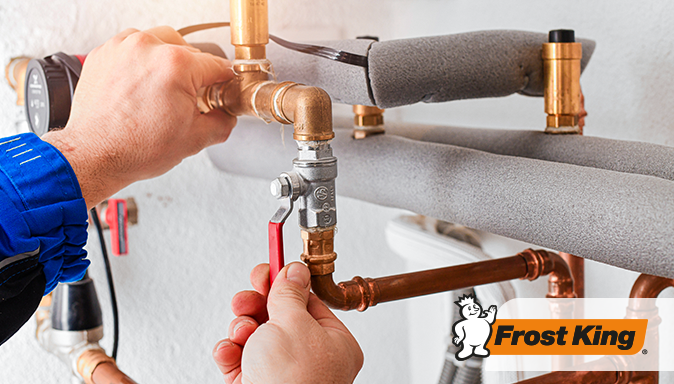Frozen ponds and icy landscapes are a lovely part of winter. Not so delightful? Frozen water pipes.
Cold winter weather can do a number on your home's plumbing. And frozen pipes are not just an inconvenience. If a pipe freezes and bursts, it can cause costly water—or even structural!—damage to your home. Fortunately, with some proactive measures and regular maintenance, you can prevent frozen pipes and ensure your plumbing system remains functional during the cold winter months.
Insulate Your Pipes
Insulation is the first line of defense against frozen pipes. Adding a layer of insulation helps your pipes maintain a consistent temperature so they don’t freeze when the air around them gets too cold. Wrap exposed pipes in basements, crawl spaces, and attics with foam pipe insulation, paying extra attention to pipes near exterior walls. This video shows you how:
Keep Your Home Warm
To keep pipes from freezing, maintaining a consistent indoor temperature is crucial. If you currently have your thermostat programmed to lower the temperature at night or when you’re away from home, be sure your set temperature is warm enough to prevent freezing, usually a minimum of 55 degrees Fahrenheit. If you have plans to be away from home for an extended period, ask a neighbor or friend to check on your home regularly to make sure the heat is on and working properly.
Seal Cracks and Gaps
Gaps and cracks in your home's foundation or walls can let in cold air that can cause pipes to freeze. Look for any openings and seal them with caulk or use Frost King Expandable Foam Weatherseal that expands to fill uneven spaces—just pinch it to compress the tape and it will grow to fill cracks anywhere between ¼-inch and 1 inch.
Keep Cabinet Doors Open
During cold snaps, open kitchen and bathroom cabinet doors to allow warm air to circulate around pipes—especially if you have faucets located on exterior walls or unheated areas of your home.
Let Faucets Drip
When temperatures plummet, letting faucets drip slowly can help prevent pipes from freezing: even just the tiniest trickle of water can reduce pressure within pipes and keep water moving so it can’t freeze.
Disconnect Outdoor Hoses and Cover Spigots
Before the first frost hits, disconnect and drain outdoor hoses and store them indoors to prevent freezing. Protect outdoor spigots and the water line that runs to them by shutting off the water supply to all outdoor faucets, then turn the handle to the “on” position to drain any water that’s left in the pipe. For an extra layer of protection, install a Frost King Faucet Protector over all outdoor spigots to insulate them and keep cold air from seeping into your home. Find step-by-step installation instructions here:
Drain the Sprinkler System
If you have an underground sprinkler system, make sure to drain it before the winter sets in. Hire a professional to shut the system down for the winter or follow the manufacturer's guidelines to make sure you do this important job right.
Service Your Heating System
A well-functioning heating system doesn’t just keep you warm. It also helps keep your home’s temperature consistent. Before winter arrives, schedule a tune up for your heating system with a professional so you don’t have to worry about it breaking down during a cold snap.
Monitor Weather Forecasts
Staying informed about bad weather can help you head off a plumbing disaster. When severe cold is predicted, leave faucets dripping, keep the heat at a higher temperature, and make sure any exposed pipes are insulated.
Install Pipe Heating Cables
For especially vulnerable areas or pipes that have a history of freezing, consider installing Automated Electric Heat Cables that wrap around pipes and provide a gentle, consistent heat to prevent freezing. Watch this video for installation tips:
Preventing frozen pipes is an important (and often overlooked) part of your winter home maintenance. These simple steps to insulate, seal, and maintain your home's plumbing can minimize the risk of frozen pipes—and the headaches and expenses associated with this homeowner disaster.
